The national flag of Eswatini (formerly Swaziland) is a powerful and visually distinctive symbol, deeply rooted in the nation's rich history, its military traditions, and its enduring commitment to peace and stability. Adopted on October 1, 1968, the flag was designed to commemorate the country's independence from British colonial rule, embodying the spirit of self-determination and the unique cultural heritage of the Swazi people. Its design elements are a direct reflection of the nation's past struggles, its present aspirations, and its vision for a unified and prosperous future.
Design and Symbolism: A Shield of Peace and Valor
The flag of Eswatini is characterized by a central black and white traditional Swazi shield, flanked by two spears and a staff adorned with feathered tassels (tinsiba). This central emblem is set against a background of five horizontal stripes of varying widths: blue (top), yellow, crimson (red), yellow, and blue (bottom). Each color and element holds profound symbolic meaning:
-
Crimson (Red) Stripe (Central): The broad central crimson stripe is the most prominent feature of the background. Red symbolizes the battles and struggles of the past, particularly those fought for the nation's independence and sovereignty. It represents the courage and determination of the Swazi people who defended their land and culture throughout history. This color embodies the sacrifices made and the resilience that defines the nation's spirit.
-
Yellow Stripes (Flanking Red): Two narrow yellow stripes border the central red band. Yellow represents the rich mineral resources of Eswatini, particularly its gold deposits, and the prosperity that these resources bring to the nation. It also symbolizes the country's agricultural wealth and the hope for economic growth and development.
-
Blue Stripes (Top and Bottom): The outermost stripes, at the top and bottom of the flag, are blue. Blue signifies peace and stability. It represents the desire of the Swazi nation to live in harmony with its neighbors and within itself, embracing a future free from conflict. This color reflects the nation's commitment to diplomatic solutions and peaceful coexistence.
-
Traditional Swazi Shield (Central Emblem): The black and white shield, positioned horizontally in the center of the red stripe, is the most iconic and culturally significant element of the flag. This is a traditional Emaswati (Swazi) Nguni shield, made from oxhide, symbolizing protection and the nation's defense against its enemies.
-
Black and White Hues of the Shield: The black and white colors of the shield symbolize racial harmony and peaceful coexistence within Eswatini. They represent the diversity of the nation's population, emphasizing unity regardless of race or origin.
-
Spears and Staff with Tinsiba: Behind the shield are two traditional spears and a staff. The spears symbolize defense and the readiness to protect the sovereignty of Eswatini. The staff, adorned with feathered tassels called tinsiba, represents the monarchical authority and the rule of law. The tinsiba (feathers of the widowbird and lourie) are traditionally worn by warriors, further emphasizing the protective aspect of the nation.
Dimensions and Proportions:
The official proportions of the Flag of Eswatini are a width-to-length ratio of 2:3. The five horizontal stripes are not of equal width. The central crimson stripe is the broadest, accounting for a significant portion of the flag's height. The two yellow stripes are narrower, and the two blue stripes are the narrowest, framing the entire design. The central shield and weapons are proportionally sized to fit within the crimson band, ensuring visual balance and prominence.
History and Evolution: From Protectorate to Kingdom
The history of the Eswatini flag is intrinsically linked to the nation's journey from a British protectorate to an independent kingdom.
-
Colonial Period (Pre-1968): Before achieving independence, Swaziland (as it was then known) was a British protectorate. The Union Flag (Union Jack) of the United Kingdom was the official flag flown alongside the protectorate's local emblems.
-
Design and Adoption (1967-1968): The current flag was first unveiled and officially adopted on April 25, 1967, though it only became the national flag upon full independence on October 1, 1968. The design was the result of a competition, and the winning entry was based on a flag presented by King Sobhuza II to the Swazi Pioneer Corps in 1941. This original flag, intended to represent the nation's military and its historical struggles, incorporated the shield, spears, and tinsiba against a black, red, and yellow background. The colors and elements were carefully chosen to symbolize the historical context and the aspirations of the newly independent state.
-
Name Change (2018): In April 2018, King Mswati III announced that the country's name would be officially changed from Swaziland to Eswatini, reverting to its pre-colonial name. While the country's name changed, the national flag design remained the same, signifying the enduring symbols and values it represents.
Regional Context and Southern African Identity:
Eswatini is a landlocked monarchy in Southern Africa, bordered by South Africa and Mozambique. Its flag, while unique, shares some commonalities with other flags in the region and on the African continent. The use of vibrant colors like red, yellow, and blue is common in African vexillology, often representing elements like struggle, resources, and peace. However, the explicit inclusion of traditional weaponry and the shield is a distinctive feature that sets it apart from many other African flags.
The flag's strong emphasis on military symbols and traditional regalia reflects Eswatini's deeply rooted monarchical system and its historical struggles to maintain independence against external pressures. This is a characteristic that resonates with other nations that have strong traditional institutions and a history of defending their sovereignty. The flag serves as a powerful reminder of Eswatini's unique cultural identity and its place within the diverse tapestry of Southern African nations.
Interesting Facts:
-
Royal Origins: The flag's design is directly inspired by a military flag presented by King Sobhuza II to the Swazi Pioneer Corps in World War II, giving it deep royal and historical roots.
-
Symbol of Military Prowess: The shield, spears, and tinsiba all symbolize the nation's military strength and its readiness to defend its sovereignty.
-
Racial Harmony: The black and white colors of the shield explicitly represent racial harmony within the nation, a significant message for a country in Southern Africa.
-
Unchanged Despite Name Change: The flag design remained the same when Swaziland changed its name to Eswatini in 2018, underscoring the enduring nature of its symbols.
-
Unique Cultural Elements: The tinsiba (feathered tassels) are unique cultural elements rarely seen on other national flags, highlighting Eswatini's distinct heritage.
-
Balance of War and Peace: The flag cleverly balances symbols of past conflict (red, shield, spears) with symbols of peace and stability (blue, black and white shield), reflecting the nation's desire for a harmonious future rooted in its history.
-
Vibrant and Recognizable: The combination of bold colors and the prominent central emblem makes the Eswatini flag highly distinctive and recognizable globally.
Significance for the Inhabitants: A Banner of Heritage, Unity, and Sovereignty
For the people of Eswatini, their national flag is more than just a piece of cloth; it is a profound embodiment of their heritage, their unity, and their hard-won sovereignty. It speaks volumes about the resilience of the Swazi people, who fought bravely to preserve their culture and independence against historical adversaries. The crimson stripe serves as a poignant reminder of the sacrifices made, fostering a deep sense of respect and gratitude for their ancestors.
The central shield and weaponry evoke a strong sense of national pride and a reminder of their duty to protect their land and traditions. The black and white colors of the shield powerfully convey the message of racial harmony and the peaceful coexistence that defines their society, encouraging all citizens to live together in understanding and mutual respect.
The blue stripes, symbolizing peace, offer a hopeful vision for the future, one where stability and tranquility prevail. When the flag is unfurled during national holidays, cultural ceremonies, or sporting events, it ignites a collective spirit of patriotism and belonging. It serves as a unifying symbol, transcending individual differences and reminding every citizen of their shared identity as the proud people of the Kingdom of Eswatini, united under their monarch and committed to their collective destiny.
In the demonstration images, full-size flags are shown with proportions of 2:3, and hand-held flags with proportions of 1:2.
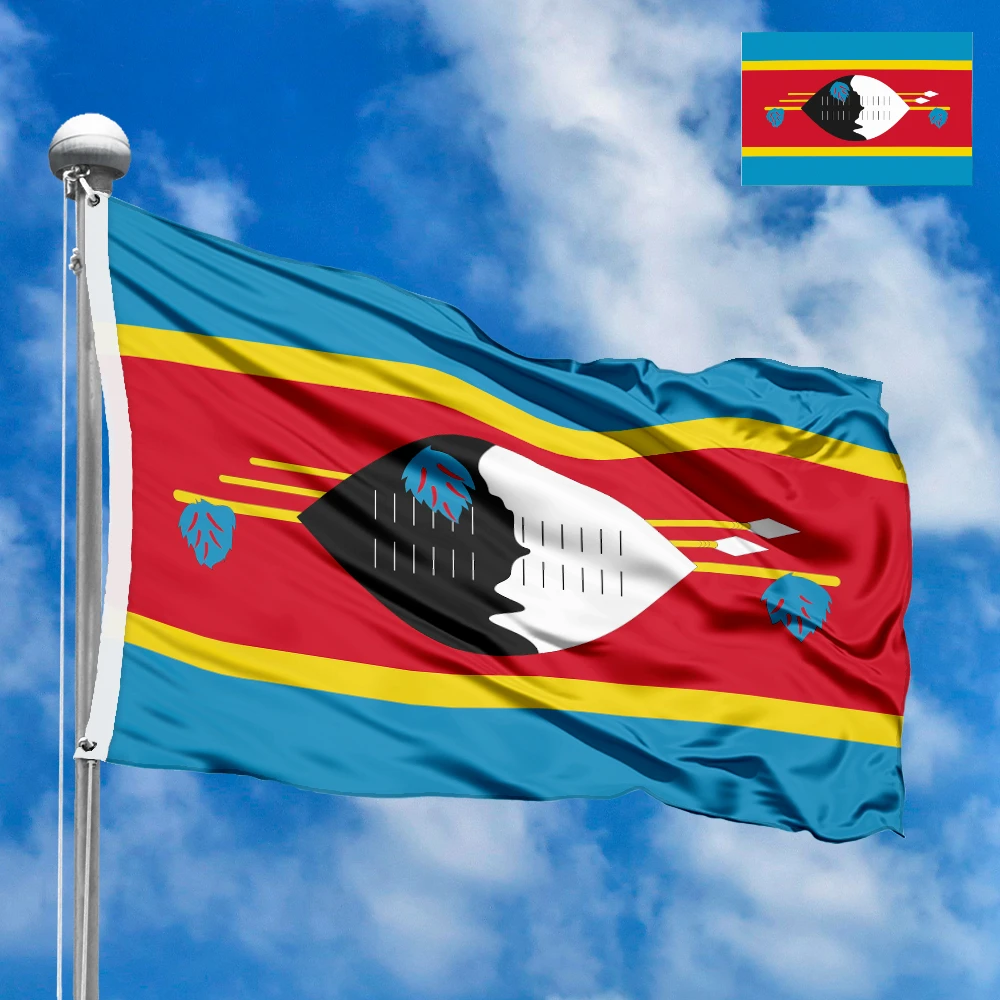

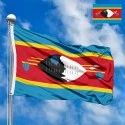
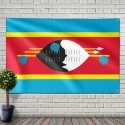
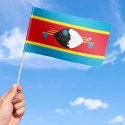
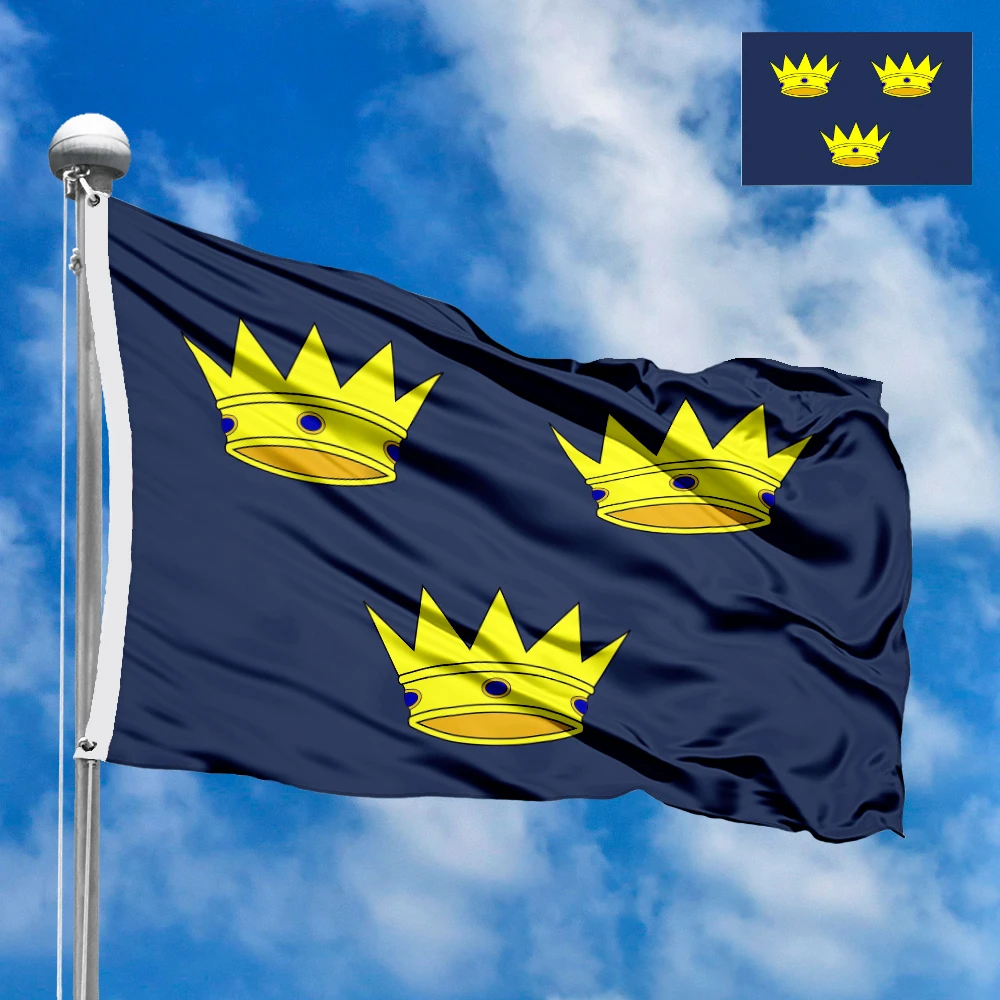

 Waving flag
Waving flag
 Sizes:
Sizes:
 Round flag
Round flag
 Sizes:
Sizes:
 Rectangular flag 2:3
Rectangular flag 2:3
 Sizes:
Sizes: